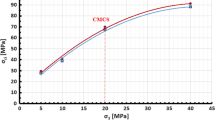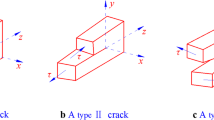Abstract
Salt rock is a polycrystalline material of interest for geostorage because of its low permeability and potential to self-heal by pressure solution at favorable stress and temperature conditions. It is often assumed that microcrack propagation and healing lead to isotropic stiffness changes. The goal of this study is to check this assumption and to gain a fundamental understanding of the mechanisms that control the accumulation of damage and irreversible deformation. Cyclic axial loading tests are performed under a confining pressure of 1 MPa on synthetic salt rock generated by thermal consolidation. The stress–strain curves and the microstructure images taken at key stages of the cycles reveal the formation of a complex system of sliding and wing microcracks, the orientation of which is loading dependent. We interpret the mechanisms that control the coupled evolution of crack families by a discrete wing crack elastoplastic damage (DWCPD) model. Crack propagation is controlled by Mode I and Mode II fracture mechanics criteria. Sliding “main” cracks grow if a cohesive frictional criterion is met, while the wing cracks propagate in tension. Displacement jumps at crack faces are related to the deformation of the rock representative elementary volume (REV). The DWCPD model can capture the nonlinear stress–strain relationship and the degradation of stiffness during the loading cycles. Simulations show that microcracks occur following two stages: (1) wing cracks initiate and main cracks do not propagate; (2) wing cracks and main cracks then propagate simultaneously. Higher friction at the crack faces leads to higher strength. With a larger cohesion, salt rock strength increases, damage development is delayed and exhibits a stick-slip evolution. At higher confinement, the initiation of wing cracks is delayed, which results in an increase of strength. The damage rate is higher in specimens that are damaged prior to compression than in the ones that are not. The proposed DWCPD model can be extended to any polycrystalline semi-brittle material, and can be applied to understand the formation of crack patterns in geostorage facilities.























Similar content being viewed by others
Abbreviations
- \(\varPsi ^*_{\text {s}}\) :
-
Helmholtz free energy of the REV
- \(G^*\) :
-
Gibbs energy of the REV
- \(\overrightarrow{n},\overrightarrow{l}\) :
-
Direction normal to a main crack plane and a wing crack plane
- \(\varvec{\sigma }, \varvec{\epsilon }\) :
-
Microscopic stress and strain tensors of a representative elementary volume (REV)
- \(\varvec{\sigma }^m, \varvec{\sigma }^w\) :
-
Stress fields that are applied at main crack faces and wing crack faces
- \(\sigma ^m_{\text {n}},\varvec{\sigma }^m_{\text {t}}\) :
-
Normal stress and the tensor of tangential stress that apply on the faces of the main crack
- \(\sigma ^m_{\text {l}}\) :
-
Net tangential stress that applies on the faces of the main crack in the direction l
- \(\sigma ^w_{\text {n}}\) :
-
Normal stress that applies on the faces of the main crack
- \(\varvec{\epsilon }^m, \varvec{\epsilon }^w\) :
-
Strain fields on main cracks and wing cracks
- \(\varvec{\epsilon }^e\) :
-
Elastic strain of the matrix
- \(\varvec{\epsilon }^{{\text {ed}}}\) :
-
Recoverable strain induced by the loss of stiffness
- \(\varvec{\epsilon }^E, \varvec{\epsilon }^p\) :
-
Elastic strain and plastic strain of the REV
- \({\varvec{t}}^m\) :
-
Traction on a main crack plane
- \(\mu , c\) :
-
friction coefficient and cohesion of main cracks
- \(N^m, B^m\) :
-
Normal and frictional indexes of a main crack
- \(\beta ^m, \varvec{\gamma }^m\) :
-
Volume fraction of the normal displacement jumps and shear displacement jumps of main cracks
- \(s_0, s_1\) :
-
Normal and shear elastic compliance of cracks
- \(\overrightarrow{T}\) :
-
Shear force applies at the faces of the main crack
- \(V_{{\text {REV}}}\) :
-
Actual volume of the REV
- \(M_{i}\) :
-
Number of cracks in family i
- \(a^m, a^w\) :
-
Crack lengths of main cracks and wing cracks
- \(\rho ^m, \rho ^w\) :
-
Crack densities of main cracks and wing cracks
- \(\beta ^w\) :
-
Volume fraction of the normal displacement jumps of wing cracks
- \(\varvec{C}_{\text {o}}\) :
-
Elastic stiffness of the matrix
- Q :
-
Number of main crack families
- \({\mathbb {N}}_{ijkl}, {\mathbb {T}}_{ijkl}\) :
-
Fourth-order tensor operators
- \(f_{\text {I}}, f_{{\text {II}}}\) :
-
Crack propagation criteria for Mode I and Mode II
- \(K_{{\text {Ic}}}, K_{{\text {IIc}}}\) :
-
Crack toughness for Mode I and Mode II
- \(K_{\text {o}}, \sigma _{\text {c}}\) :
-
Constitutive parameters for toughness
- \(\varvec{\varOmega }\) :
-
Macroscopic damage variable of the REV
- \(\varvec{\varOmega}_{\text {m}}, \varvec{\varOmega}_{\text {w}}\) :
-
Macroscopic damage variable of main cracks and wing cracks
- d :
-
Trace of Macroscopic damage variable of the REV
- \(f_{\text {p}}\) :
-
Plastic yield surface function
- g :
-
Plastic potential function
- \(q, p, \theta\) :
-
Deviatoric stress, mean stress, and Lode’s angle
- \(J_2, J_3\) :
-
The second and third stress invariants
- e :
-
Cohesion constant of the rock
- \(\alpha _{\text {p}}\) :
-
Plastic hardening function
- \(m_\theta\) :
-
The parameter controlling the effect of Lode’s angle
- \(\chi\) :
-
The parameter controlling the effect of damage
- \(\eta\) :
-
The parameter controlling the boundary of the compressive dilation zone
- R :
-
The parameter controlling plastic hardening rate
- \(\lambda , \omega\) :
-
Plastic multiplier and the plastic hardening variable
- \(\alpha _{\text {p}}^o, \alpha _{\text {p}}^m\) :
-
The plastic yielding threshold and the maximum of the hardening function
References
Arson C, Gatmiri B (2011) Numerical study of damage in unsaturated geological and engineered barriers. Phys Chem Earth Parts A/B/C 36(17–18):1981–1989
Bažant P, Oh B (1986) Efficient numerical integration on the surface of a sphere. ZAMM J Appl Math Mech 66(1):37–49
Bobet A (1998) Fracture coalescence in rock materials: Experimental observations and numerical predictions
Bobet A, Einstein H (1998) Fracture coalescence in rock-type materials under uniaxial and biaxial compression. Int J Rock Mech Min Sci 35(7):863–888
Budiansky B, O’connell RJ (1976) Elastic moduli of a cracked solid. Int J Solids Struct 12(2):81–97
Chaboche JL (1981) Continuous damage mechanics–a tool to describe phenomena before crack initiation. Nucl Eng Des 64(2):233–247
Chan KS, Bodner SR, Munson DE (2001) Permeability of wipp salt during damage evolution and healing. Int J Damage Mech 10(4):347–375
Chiarelli AS, Shao JF, Hoteit N (2003) Modeling of elastoplastic damage behavior of a claystone. Int J Plast 19(1):23–45
Cicekli U, Voyiadjis GZ, Al-Rub RKA (2007) A plasticity and anisotropic damage model for plain concrete. Int J Plast 23(10–11):1874–1900
Cosenza P, Ghoreychi M, Bazargan-Sabet B, De Marsily G (1999) In situ rock salt permeability measurement for long term safety assessment of storage. Int J Rock Mech Min Sci 36(4):509–526
Ding J (2019) Grain boundary processes, anelasticity, and test of the effective stress law for semibrittle deformation of synthetic salt-rocks. PhD thesis, Texas A&M University
Ding J, Chester FM, Chester JS, Zhu C, Arson C (2016) Mechanical behavior and microstructure development in consolidation of nominally dry granular salt. In: 5th symposium of the American Rock Mechanics Association
Ding J, Chester FM, Chester JS, Xianda S, Arson C (2017) Microcrack network development in salt-rock during cyclic loading at low confining pressure. Am Rock Mech Assoc
Dyskin A, Salganik R (1987) Model of dilatancy of brittle materials with cracks under compression. Mech Solids 22(6):165–173
Gambarotta L, Lagomarsino S (1993) A microcrack damage model for brittle materials. Int J Solids Struct 30(2):177–198
Germanovich L, Salganik R, Dyskin A, Lee K (1994) Mechanisms of brittle fracture of rock with pre-existing cracks in compression. Pure Appl Geophys 143(1–3):117–149
Griffith A (1924) The theory of rupture. In: First Int. Cong. Appl. Mech, pp 55–63
Halm D, Dragon A (1996) A model of anisotropic damage by mesocrack growth; unilateral effect. Int J Damage Mech 5(4):384–402
Hawkes I, Mellor M (1970) Uniaxial testing in rock mechanics laboratories. Eng Geol 4(3):179–285
Hayakawa K, Murakami S (1997) Thermodynamical modeling of elastic-plastic damage and experimental validation of damage potential. Int J Damage Mech 6(4):333–363
Hoek E, Bieniawski Z, et al. (1966) Fracture propagation mechanism in hard rock. In: 1st ISRM Congress, international society for rock mechanics
Jin W, Arson C (2017a) Discrete equivalent wing crack based damage model for brittle solids. Int J Solids Struct 110:279–293
Jin W, Arson C (2017b) Micromechanics based discrete damage model with multiple non-smooth yield surfaces: Theoretical formulation, numerical implementation and engineering applications. Int J Damage Mech 27(5):611–639. https://doi.org/10.1177/1056789517695872
Kachanov M (1992) Effective elastic properties of cracked solids: critical review of some basic concepts. Appl Mech Rev 45(8):304. https://doi.org/10.1115/1.3119761
Kachanov ML (1982) A microcrack model of rock inelasticity. Part I: Frictional sliding on microcracks. Mech Mater 1(1):19–27
Krajcinovic D, Fanella D (1986) A micromechanical damage model for concrete. Eng Fract Mech 25(5–6):585–596
Kwon S, Wilson JW (1999) Deformation mechanism of the underground excavations at the wipp site. Rock Mech Rock Eng 32(2):101–122
Lehner F, Kachanov M (1996) On modelling of ‘winged” cracks forming under compression. Int J Fract 77(4):R69–R75
Lemaitre J, Desmorat R (2005) Engineering damage mechanics: ductile, creep, fatigue and brittle failures. Springer, Berlin
Pensée V, Kondo D, Dormieux L (2002) Micromechanical analysis of anisotropic damage in brittle materials. J Eng Mech 128(8):889–897
Salari M, Saeb S, Willam K, Patchet S, Carrasco R (2004) A coupled elastoplastic damage model for geomaterials. Comput Methods Appl Mech Eng 193(27–29):2625–2643
Scholtès L, Donzé FV (2012) Modelling progressive failure in fractured rock masses using a 3d discrete element method. Int J Rock Mech Min Sci 52:18–30
Shao J, Jia Y, Kondo D, Chiarelli A (2006) A coupled elastoplastic damage model for semi-brittle materials and extension to unsaturated conditions. Mech Mater 38(3):218–232. https://doi.org/10.1016/j.mechmat.2005.07.002
Simo J, Ju J (1987) Strain-and stress-based continuum damage models formulation—i. Int J Solids Struct 23(7):821–840
Spiers C, Urai J, Lister G, Boland J, Zwart H (1986) The influence of fluid-rock interaction on the rheology of salt rock, 1st edn. Commission of the European Communities, Luxembourg
Van Eekelen H (1980) Isotropic yield surfaces in three dimensions for use in soil mechanics. Int J Numer Anal Meth Geomech 4(1):89–101
Yuan S, Harrison J (2006) A review of the state of the art in modelling progressive mechanical breakdown and associated fluid flow in intact heterogeneous rocks. Int J Rock Mech Min Sci 43(7):1001–1022
Zhu C, Arson C (2015) A model of damage and healing coupling halite thermo-mechanical behavior to microstructure evolution. Geotech Geol Eng 33(2):389–410
Acknowledgements
This research was supported by the U.S. National Science Foundation under Grants CMMI-1362004/1361996 (“Collaborative research: Linking Salt Rock Deformation Regimes to Microstructure Organization”) and under Grant CMMI-1552368 (“CAREER: Multiphysics Damage and Healing of Rocks for Performance Enhancement of Geo-Storage Systems—A Bottom-Up Research and Education Approach”).
Author information
Authors and Affiliations
Corresponding author
Ethics declarations
Conflict of Interest
The authors declare that they have no conflict of interest.
Additional information
Publisher's Note
Springer Nature remains neutral with regard to jurisdictional claims in published maps and institutional affiliations.
Rights and permissions
About this article
Cite this article
Shen, X., Arson, C., Ding, J. et al. Mechanisms of Anisotropy in Salt Rock Upon Microcrack Propagation. Rock Mech Rock Eng 53, 3185–3205 (2020). https://doi.org/10.1007/s00603-020-02096-1
Received:
Accepted:
Published:
Issue Date:
DOI: https://doi.org/10.1007/s00603-020-02096-1




